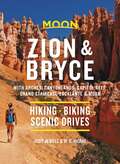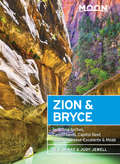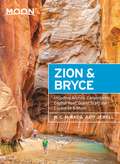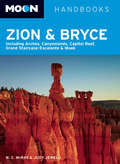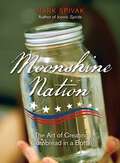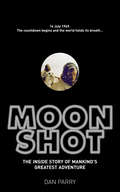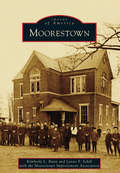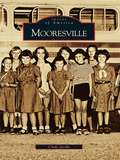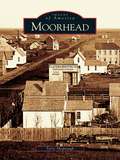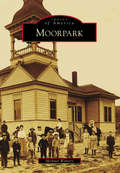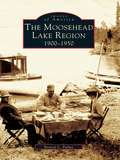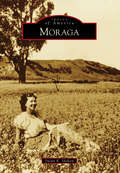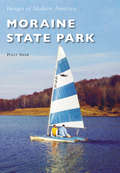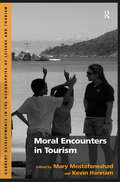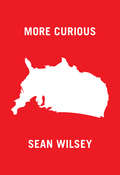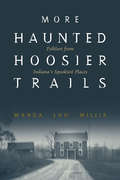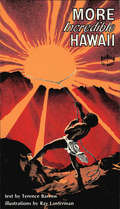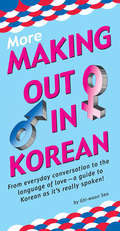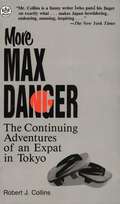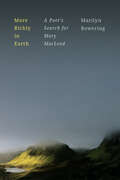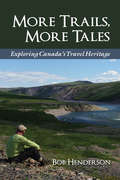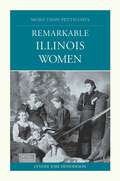- Table View
- List View
Moon Zion & Bryce: Hiking, Biking, Scenic Drives (Travel Guide)
by Judy Jewell W. C. McRaeExplore the colorful hoodoos, canyons, and iconic arches of all five of Utah's national parks with Moon Zion & Bryce. Inside you'll find:Flexible Itineraries: Unique and adventure-packed ideas ranging from one day in each park to a week-long road trip covering all of them, designed for outdoor adventurers, road-trippers, families, and moreThe Best Hikes in Utah's National Parks: Individual trail maps, mileage and elevation gains, and backpacking options for Zion, Bryce Canyon, Canyonlands, Arches, Capitol Reef, and Grand Staircase-EscalanteExperience the Outdoors: Snap a pic on a sunrise hike or get your adrenaline pumping on a white-water rafting excursion down the Colorado River. Explore the beautiful remains of ancient Native American rock art throughout the parks or discover the creative, energetic spirit of the nearby town of Moab. Enjoy the serenity of Bryce in winter on cross-country skis or take a week-long summer road trip to hit every park on your listHow to Get There: Up-to-date information on gateway towns like Moab, park entrances, park fees, and toursWhere to Stay: Campgrounds, resorts, and more both inside and outside the parksPlanning Tips: When to go, what to pack, safety information, and how to avoid the crowds, with full-color photos and easy-to-use maps throughoutHelpful resources on Covid-19 and traveling to Utah's national parksExpertise and Know-How: Seasoned explorers W.C. McRae and Judy Jewell share tips for travelers who want to backpack, mountain bike, raft, rock climb, hike, and moreWith Moon Zion & Bryce's expert advice and in-depth coverage, you can find your adventure. Visiting more of North America's incredible national parks? Try Moon USA National Parks, Moon Yellowstone & Grand Teton, or Moon Glacier National Park. Hitting the road? Try Moon Southwest Road Trip. About Moon Travel Guides: Moon was founded in 1973 to empower independent, active, and conscious travel. We prioritize local businesses, outdoor recreation, and traveling strategically and sustainably. Moon Travel Guides are written by local, expert authors with great stories to tell—and they can't wait to share their favorite places with you.For more inspiration, follow @moonguides on social media.
Moon Zion & Bryce: Including Arches, Canyonlands, Capitol Reef, Grand Staircase-escalante & Moab (Moon Handbooks Ser.)
by W. C. Mcrae Judy JewellMoon Travel Guides: Find Your AdventureWith five national parks within a day's drive of one another, southern Utah is a dream destination for spectacular outdoor adventure and staggering natural beauty. Moon Zion & Bryce is the ultimate guide to crafting a memorable journey through this diverse and thrilling landscape.Moon Zion & Bryce features:Full coverage of southern Utah's five national parks and their surrounding regions: Zion National Park, Bryce Canyon National Park, Canyonlands National Park, Arches National Park, and Capitol Reef National ParkItineraries for every timeline and travel style, ranging from one day in each park to a week-long road trip covering all of them, including: Avoiding the Crowds, Red Rocks Road Trip, Ancient Rock Art, Best Day Hikes, and Family FunFull-color, vibrant photos and detailed maps of each park Strategies for getting to the parks and traveling between them, with suggestions on the best places to stop along the way to eat, rest, or exploreExpert tips for travelers looking to go backpacking, canyoneering, mountain biking, rafting, rock climbing, horseback riding, or hiking, plus essential packing and health and safety informationThe top activities and unique ideas for exploring each park: Find the best spot for photographing the sunrise, or embark on an adrenaline pumping white-water rafting excursion down the Colorado River. Enjoy the serenity of Bryce in the winter season with a cross-country ski day, or take a week-long summer road trip to hit every spot on your list. Explore the beautiful remains of ancient Native American rock art on display all over the parks, or discover the creative, energetic spirit of nearby MoabValuable insight from seasoned explorers and regional experts Bill McRae and Judy JewellWhere to stay inside and outside the parks, including the best spots to pitch a tent, park your RV, or relax at an upscale resortUp-to-date information on park fees, passes, and reservationsCoverage of gateway cities and towns, including Moab and less crowded areas like Kodachrome Basin and EscalanteRecommendations for families, LGBTQ+ travelers, seniors, international visitors, travelers with disabilities, and traveling with petsThorough background on the wildlife, terrain, culture, and historyHitting more of North America's incredible national parks? Try Moon Grand Canyon, Moon Yellowstone & Grand Teton, or Moon Glacier National Park. Hitting the road? Try Moon Southwest Road Trip.
Moon Zion & Bryce: With Arches, Canyonlands, Capitol Reef, Grand Staircase-Escalante & Moab (Travel Guide)
by Judy Jewell W. C. McRaeExplore the colorful hoodoos, canyons, and iconic arches of all five of Utah's national parks with Moon Zion & Bryce. Inside you'll find:Flexible Itineraries: Unique and adventure-packed ideas ranging from one day in each park to a week-long road trip covering all of them, designed for outdoor adventurers, road-trippers, families, and more The Best Hikes in Utah's Parks: Individual trail maps, mileage and elevation gains, and backpacking options for Zion, Bryce Canyon, Canyonlands, Arches, Capitol Reef, and Grand Staircase-Escalante Experience the Outdoors: Snap a pic on a sunrise hike or get your adrenaline pumping on a white-water rafting excursion down the Colorado River. Explore the beautiful remains of ancient Native American rock art throughout the parks or discover the creative, energetic spirit of the nearby town of Moab. Enjoy the serenity of Bryce in winter on cross-country skis or take a week-long summer road trip to hit every park on your listHow to Get There: Up-to-date information on gateway towns like Moab, park entrances, park fees, and toursWhere to Stay: Campgrounds, resorts, and more both inside and outside the parkPlanning Tips: When to go, what to pack, safety information, and how to avoid the crowds, with full-color photos and detailed maps throughoutExpertise and Know-How: Seasoned explorers W.C. McRae and Judy Jewell share tips for travelers who want to backpack, mountain bike, raft, rock climb, hike, and moreWith Moon Zion & Bryce's expert advice and in-depth coverage, you can find your adventure.Visiting more of North America's incredible national parks? Try Moon USA National Parks, Moon Yellowstone & Grand Teton, or Moon Glacier National Park. Hitting the road? Try Moon Southwest Road Trip.
Moon Zion and Bryce: 2011
by W. C. Mcrae Judy JewellSeasoned travel writers W. C. McRae and Judy Jewell offer an in-depth look at the National Parks of southeastern Utah, from the awe-inspiring sandstone cliffs of Zion to the otherworldly rock formations of Arches. The authors provide suggestions for great trips such as the Best of Southern Utah's National Parks and Standing High: The Best Vistas. Packed with information on dining, transportation, and accommodations, Moon Zion & Bryce has lots ofoptions for a range of travel budgets. Every Moon guidebook includes recommendations for must-see sights and many area, regional, and city-centered maps. With advice on hiking the remote corners of Canyonlands, mountain biking in Slickrock Canyon, and finding the best brewpub in Moab, Moon Zion& Bryce gives travellers the tools they need to create a more personal and memorable experience. With expert writers, first-rate strategic advice, and an essential dose of humour, Moon guidebooks are the cure for the common trip.
Moon Zion and Bryce: 2013
by Judy Jewell Bill McraeSeasoned travel writers W. C. McRae and Judy Jewell offer an in-depth look at the national parks of southeastern Utah, from the awe-inspiring sandstone cliffs of Zion to the otherworldly rock formations of Arches. The authors provide suggestions for great trip ideas, such as the Best of Southern Utah's National Parks and Standing High: The Best Vistas. Packed with information on dining, transportation, and accommodations, this handbook has lots of options for a range of travel budgets. With advice on hiking the remote corners of Canyonlands, mountain biking in Slickrock Canyon, and finding the best brewpub in Moab, Moon Zion & Bryce gives travelers the tools they need to create a more personal and memorable experience.
Moonshine Nation: The Art of Creating Cornbread in a Bottle
by Mark SpivakMoonshine is corn whiskey, traditionally made in improvised stills throughout the Appalachian South. While quality varied from one producer to another, the whiskey had one thing in common: It was illegal because the distiller refused to pay taxes to the US government. Many moonshiners were descendants of Scots-Irish immigrants who had fought in the original Whiskey Rebellion in the early 1790s. They brought their knowledge of distilling with them to America along with a profound sense of independence and a refusal to submit to government authority. Today many Southern states have relaxed their laws and now allow the legal production of moonshine—provided that taxes are paid. Yet many modern moonshiners retain deep links to their bootlegging heritage. Moonshine Nation is the story of moonshine&’s history and origins alongside profiles of modern moonshiners—and a collection of drink recipes from each.
Moonshot: The Inside Story of Mankind's Greatest Adventure
by Dan Parry'It didn't matter that they were now three miles beyond their target site, that communications were dropping out and that they were running low on fuel. All that mattered to Neil as he searched for a safe spot to land was that boulders littered the surface below. "Thirty seconds," called mission control. In truth, the flight controllers were now no more than spectators, just like everybody else. No more needed to be said.It was down to Armstrong.'Simultaneously connected and separated by television, millions of people around the world held their breath as a human being looked back at them from the surface of the Moon. Yet who were these men capable of such an achievement? How did the passionate Buzz Aldrin, inscrutable Michael Collins and enigmatic Neil Armstrong learn to depend on one another as they endured the most intense period of their lives?From the personal tragedies and triumphs they encountered along the way to the terrifying climax of a mission that redefined humanity, Moonshot - now also a major TV factual-drama - draws on interviews with many of the leading participants and hundreds of hours of archive material to tell the compelling true story of an event that captured the imagination of generations, then and now.
Moorestown (Images of America)
by Moorestown Improvement Association Kimberly L. Bunn Lynne F. SchillSettled in 1682 by Quakers, Moorestown grew quickly into an important agricultural and social hub. Local farms and nurseries were considered the best in the state with their superior produce and specimen plants, and the coming of the railroad in the 1860s brought industrial leaders who helped the town to grow and prosper beyond its agrarian roots. It became the home of Eldridge R. Johnson, cofounder of the Victor Talking Machine Company, and Alice Paul, a women's suffrage champion. Moorestown provided easy access to New York City and surrounding urban centers, and it continued to be a mix of sought-after residential neighborhoods, working farms, and thriving businesses. Since 1904, the Moorestown Improvement Association has been instrumental in the town's growth, with contributions including funding the first artesian well, purchasing land for the first parks and athletic fields, and registering the town in the National Register of Historic Places.
Mooresville
by Cindy JacobsIt was a hot afternoon in August 1856 when people in southern Iredell County, North Carolina, gathered for a special event. The train was on its way, bringing officials, a brass band, and the economic future. John Franklin Moore viewed the railroad tracks as an opportunity to fulfill his dream of starting a community and building a town. He knew that trains would bring customers and new citizens and carry freight to and from markets. Moore took a bold step by providing land for a depot and siding and offering land for homes and businesses. Moore's Siding prospered and grew, and in 1873, the village was incorporated and named Mooresville to honor the founder. Generations of Mooresville citizens have taken daring steps into the future, building a community that is more than just a place--it's a home. This is a story of Mooresville, the Queen of Iredell.
Moorhead
by Terry ShoptaughMoorhead, Minnesota, was founded in 1872 as a major stop on the Northern Pacific Railroad during its push toward the Pacific Ocean. The town grew to prominence in western Minnesota because of its location at the intersection of the rail line and the commercially important Red River of the North. Garnering an unenviable reputation in its early years as a wide-open town, dominated by its saloons, Moorhead subsequently developed as an important rural service center. Tracing the history of Moorhead from its founding in 1872 to the present day, the images in this volume reveal the experiences of this small Midwestern community within a framework of change and continuity.
Moorpark (Images of America)
by Michael WintersThe story of Moorpark begins with a town that was built in the right place at the right time. In the 1890s, when the Southern Pacific Railroad announced plans to relocate its Coast Line through Chatsworth to Ventura, land speculation ensued. Robert W. Poindexter, secretary of the Simi Land and Water Company, owned the plot of land that became Moorpark and laid out the townsite in 1900. A depot was quickly built, and soon, trains were arriving daily. Shortly thereafter, an application for a post office was also approved. After the completion of the Santa Susana tunnels in 1904, Moorpark began to grow. Historically, Moorpark's main source of revenue has been agriculture. Initially, dry land farming, including apricots, was preferred. As irrigation techniques improved, walnuts and citrus became the major crops. Its extensive apricot production endowed Moorpark with the title "Apricot Capital of the World." After World War II, the poultry industry became big business, with turkey, chicken, and egg ranches dotting the landscape.
Moosehead Lake Region 1900-1950, The: 1900-1950 (Images of America)
by Everett L. ParkerThe Moosehead Lake region has long been a place where travelers go to escape. In the first half of the twentieth century, the region became a mecca for hunters and fishermen, as well as for travelers looking for rest and relaxation at popular resorts such as the Mount Kineo House. The Moosehead Lake Region: 1900-1950 uses vintage photographs to tell the story of this Maine retreat. The images depict visitors and residents of Greenville, Shirley, Rockwood, Beaver Cove, and Kokadjo; the lumbering era in the North Woods; and the locomotives whose whistles pierced the wilderness.
Moraga (Images of America)
by Susan K. SkiltonLong before the Gold Rush drew settlers from the East, the land that would one day be developed into the town of Moraga was situated on a large rancho owned by the Moraga family. Nestled amongst hills just east of Oakland and Berkeley, the Moraga Valley of the 19th century attracted cattle ranchers and farmers who planted vegetables, fruit, and nuts. In particular, pear orchards established in the earliest farming days are still celebrated in the city's annual Pear & Wine Festival. In the early 20th century, tourists escaped the sometimes chilly and fog-bound cities near San Francisco Bay to picnic in the Moraga redwoods. Electric trains, which brought Moraga's commuters to cities and students to St. Mary's College, enabled the growth of subdivisions and businesses. Train tracks eventually gave way to trails for hiking, biking, and horseback riding. Once considered a potential site for the United Nations, Moraga has maintained its rural beauty while developing into a thriving suburb.
Moraine State Park (Images of Modern America)
by Polly ShawAbout 20,000 years ago, the late Wisconsinan glaciation reached its maximum extent. Glacial deposits identify the moraine, or farthest area covered by the glacier. Muddy Creek was a north-flowing stream that was blocked by the south-advancing glacier, forming a huge lake that lasted until the glacier dam began to retreat. The lake rapidly drained, eventually exposing the vast Muddy Creek basin. Dr. Frank Preston envisioned recreating the ancient glacial lake and worked with the Western Pennsylvania Conservancy to begin the project that became 16,725-acre Moraine State Park. Its centerpiece, man-made Lake Arthur and the surrounds, provide outstanding outdoor recreation and relaxation opportunities.
Moral Encounters in Tourism (Current Developments In The Geographies Of Leisure And Tourism Ser.)
by Kevin Hannam Mary MostafanezhadThis first full length treatment of the role of morality in tourism examines how the tourism encounter is also fundamentally a moral encounter. Drawing upon interdisciplinary perspectives, leading and new authors in the field address topics that range from volunteer tourism to fertility tourism to reveal new insights into the ways tourism encounters are implicated in, and contribute to, broader moral reconfigurations in Western and non-Western contexts. Illustrating the role of power and power relations in tourism encounters within different political, economic, environmental and cultural contexts, the authors in this anthology analyse, theoretically and empirically, the implications of the privileging of some moralities at the expense of others. Key themes include the moral consumption of tourism experiences, embodiment in tourism encounters, environmental moralities as well as methodological aspects of morality in tourism research. Crossing disciplinary and chronological boundaries, Moral Encounters in Tourism provides a much-anticipated overview of this new interdisciplinary terrain and offers possible routes for new research on the intersection of morality and tourism studies.
More Curious
by Sean WilseyIn More Curious, Sean Wilsey travels across the U.S., from the launchpad at Cape Canaveral, to the isolated artists' enclave of Marfa, Texas, to the boardrooms and ballrooms of post-9/11 New York City. Wherever he is, Wilsey captures his surroundings with the precision of a photographer and the raw grace of a skateboarder (he's an amateur practitioner of both arts). And his eye always finds an unrivaled intensity of detail: here, and only here, will a reader be privy to the Dostoyevskian whiff of Marfa's fugitive underbelly, the unsung delights of a skater rag's cooking column, the exact amount of time elapsed since the soundwaves of a long-lost, legendary World Cup broadcast passed out of our solar system.These essays-originally published in Vanity Fair, GQ, McSweeney's, and elsewhere-comprise nearly fifteen years of Wilsey's most vital work on the glory and the misery, the beauty and absurdity of contemporary America.
More Haunted Hoosier Trails
by Wanda Lou WillisIndiana folklorist Wanda Lou Willis is back with all-new ghostly tales in this hair-raising companion to Haunted Hoosier Trails. Wanda explores Indiana's hidden history in spooky locations around the state. Local history buffs will relish the informative county histories that begin each chapter, while thrill-seekers will eagerly search out these frightening spots. More Haunted Hoosier Trails is perfect year-round for raising goose-bumps around the campfire or reading under the covers with a flashlight.
More Hidden Walks in the Bay Area: Pathways, Essays, and Yesterdays
by Stephen AltschulerThe thirty walking tours in the San Francisco Bay Area in this book follow paths, lanes, stairways, and streets. Walkers encounter creeks, waterfalls, redwood groves, and enchanting homes that blend into the landscape.
More Incredible Hawaii
by Ray Lanterman Terence BarrowThis book is the fruit of a collaboration between author-anthropologist Terence Barrow and artist-illustrator Ray Lanterman. It is a worthy successor to their INCREDIBLE HAWAil published by the Charles E.Tuttle Company in 1974. The first book was received with enthusiasm by tourists, residents, and school readers of various grades. Teachers said it enlivened Hawaiian history. The fifty-two illustrated essays of MORE INCREDIBLE HAWAII, are even more fascinating than the first series. The convenient format chosen by the publisher is again that of the standard Tut Book noted for high quality paper and presentation. MORE INCREDIBLE HAWAil is an admirable companion to INCREDIBLE HAWAll and should receive the same enthusiastic reception.
More Incredible Hawaii
by Ray Lanterman Terence BarrowThis book is the fruit of a collaboration between author-anthropologist Terence Barrow and artist-illustrator Ray Lanterman. It is a worthy successor to their INCREDIBLE HAWAil published by the Charles E.Tuttle Company in 1974. The first book was received with enthusiasm by tourists, residents, and school readers of various grades. Teachers said it enlivened Hawaiian history. The fifty-two illustrated essays of MORE INCREDIBLE HAWAII, are even more fascinating than the first series. The convenient format chosen by the publisher is again that of the standard Tut Book noted for high quality paper and presentation. MORE INCREDIBLE HAWAil is an admirable companion to INCREDIBLE HAWAll and should receive the same enthusiastic reception.
More Making Out in Korean: (Korean Phrasebook)
by Ghi-Woon SeoMore Making Out in Korea is a fun, accessible and thorough Korean phrase book and guide to the Korean language as it's really spoken.<P><P>This prasebook follows the bestselling Making Out in Korea providing additional (and classic) phrases for travelers, including ones to help you make acquaintances, discuss likes and dislikes, share a meal, go out on the town or develop a romantic relationship.This Korean phrasebook includes: A guide to pronouncing Korean words correctly. Explanations of basic Korean grammar, such as, word order, questions, and formal vs. informal tenses. Complete Korean translations including Korean Script (hangul). Useful and interesting notes on Korean language and culture. Lots of colorful, fun and useful expressions not covered in other phrasebooks.
More Max Danger
by Robert J. CollinsLife with Max Danger is never dull-as all readers of the first, best-selling volume of his adventures as an expatriate in Tokyo will know.More Max Danger provides more entertainment and more pleasure. It will delight not only all of Max's old friends, but also all those who have only recently made his acquaintance.
More Richly in Earth: A Poet’s Search for Mary MacLeod
by Marilyn BoweringMary MacLeod (Màiri nighean Alasdair Ruaidh) was a rarity: a female bard in seventeenth-century Scotland. While her lyrics were honoured, she was also marginalized, denigrated as a witch, and exiled, both for being a writer and for what she wrote.Presented as a chronicle of journeys through the Scottish Hebrides, More Richly in Earth explores MacLeod’s legacy, preserved within landscape, memory, and identity. In an act of recovery and restoration, Canadian poet and novelist Marilyn Bowering pieces together the puzzle of radically different accounts of MacLeod’s life, returning to the places the bard once lived with the help of contemporary Scottish Gaelic poets and scholars. Through investigation and imagination, Bowering forms a connection with MacLeod despite vast differences of culture and language, time and place. Their connection deepens as Bowering twines MacLeod’s story with accounts of the people and places that shaped her own life, a connection that ultimately reveals the foundations of Bowering’s artistic vocation to herself.MacLeod’s life and writing, little known today beyond the Gaelic world, harbours cultural truths about a transformative era of war and colonization in Gaelic Scotland. Bringing a poetic sensibility to investigative scholarship, More Richly in Earth offers a profound reflection on the necessity of art in all forms.
More Trails, More Tales: Exploring Canada's Travel Heritage
by Bob HendersonAn entertaining book of trivia, anecdotes, and observations about heritage travel in Canada. Inspired by and drawing on Canadian exploration, Bob Henderson’s newest book, More Trails, More Tales, strikes a balance with travel literature, history, geography, anthropology, literature, and philosophy. It will delight outdoor enthusiasts, serious naturalists, educators, and armchair travellers alike. It is essentially a storytelling book, highlighting Canadian stories and examining different aspects of heritage travel in Canada.
More than Petticoats: Remarkable Illinois Women (More than Petticoats Series)
by Lyndee HendersonMore than Petticoats: Remarkable Illinois Women chronicles the stories of twelve Illinois women who lived in the era of True Womanhood and dedicated themselves to charity toward family and strangers. Unwittingly, these women forged a legacy that expanded well beyond Illinois' borders.From First Lady Mary Todd Lincoln's devotion to country to ballroom dancer Irene Castle's fight for animal rights, the women of Illinois acted with progressive vision.Meet the wife of the Mormon Prophet, Emma Hale Smith, who challenged ideology; Nobel Peace Prize winner Jane Addams, the model of usefulness;Myra Bradwell, considered America's first woman lawyer; and African American entrepreneur Annie Minerva Malone, who built a beauty empire.Born before the dawn of the twentieth century, the women herein paved the way for future generations. Author Lyndee Jobe Henderson presents absorbing biographies filled with rarely published details.
